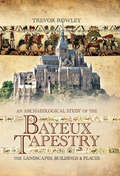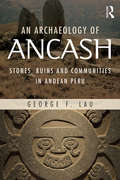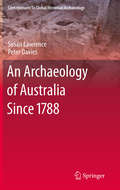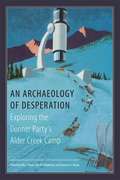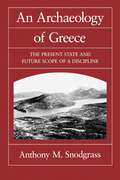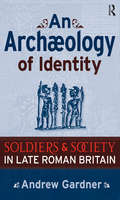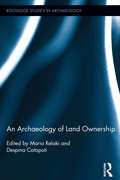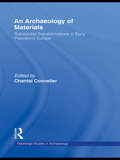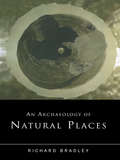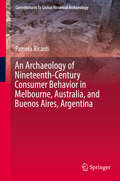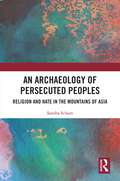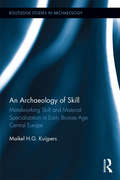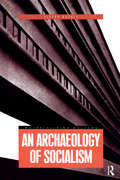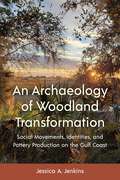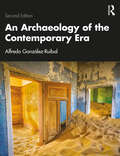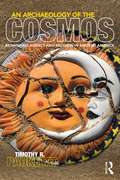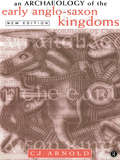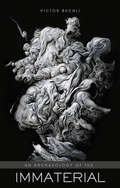- Table View
- List View
An Archaeological Study of the Bayeux Tapestry: The Landscapes, Buildings and Places
by Trevor RowleyAn analysis of the famed medieval English tapestry through examination of the depicted landscapes, towns, castles, and other structures.An Archaeological Study of the Bayeux Tapestry provides a unique re-examination of this famous piece of work through the historical geography and archaeology of the tapestry. Trevor Rowley is the first author to have analyzed the tapestry through the landscapes, buildings and structures shown, such as towns and castles, while comparing them to the landscapes, buildings, ruins and earthworks which can be seen today. By comparing illustrated extracts from the tapestry to historical and contemporary illustrations, maps and reconstructions Rowley is able to provide the reader with a unique visual setting against which they are able to place the events on the tapestry. This approach allows Rowley to challenge a number of generally accepted assumptions regarding the location of several scenes in the tapestry, most controversially suggesting that William may never have gone to Hastings at all. Finally, Rowley tackles the missing end of the tapestry, suggesting the places and events which would have been depicted on this portion of William&’s journey to Westminster.Praise forAn Archaeological Study of the Bayeux Tapestry &“We all know what the Bayeux Tapestry celebrates in its iconic artwork, but Trevor Rowley goes one step further and looks at the buildings and characters with a view actually identifying them! Absolutely fascinating, brings a whole new dimension to the study of this amazing artefact.&” —Books Monthly &“Rowley&’s arguments are copiously illustrated with details from the tapestry, photographs and plans. It results in very densely packed chapters well worth reading, and you certainly will never look at that tea towel in the same way again.&” —Hexham Local History Society
An Archaeology of Ancash: Stones, Ruins and Communities in Andean Peru
by George LauAn Archaeology of Ancash is a well–illustrated synthesis of the archaeology of North Central Peru, and specifically the stone structures of the Ancash region. All the major cultures of highland Ancash built impressive monuments, with no other region of South America showing such an early and continuous commitment to stone carving. Drawing on Lau’s extensive experience as an archaeologist in highland Peru, this book reveals how ancient groups of the Central Andes have used stone as both a physical and symbolic resource, uncovering the variety of experiences and meanings which marked the region’s special engagement with this material. An abundant raw resource in the Andes, stone was used for monuments, sculptures and other valuables such as carved monoliths, which were crucial to the emergence of civilization in the region, and religious objects from magical charms to ancestor effigies. Detailing the ways stone has played both an everyday and an extraordinary part in ancient social life, Lau also examines how cultural dispositions towards this fundamental material have changed over time and considers how contemporary engagements with these stone remains have the potential to create and regenerate communities. With an ample selection of color photos which bring these sites and artifacts to life, An Archaeology of Ancash is an essential guide to the key monuments, places and objects that distinguish this region and its rich archaeological heritage.
An Archaeology of Architecture: Photowriting the Built Environment
by Dennis TedlockPage by page, this book takes us on a journey through the built world that ranges from Greece to Guatemala and from New York to San Francisco. Tedlock practices what he calls photowriting, a creative process that brings photographer and writer together in the same person. It may be true enough that a photograph can show more than words can say, but it is equally true that words can say more than a photograph can show. A third space opens up in the middle, where the viewer reader can look back and forth between image and text at will.Tedlock looks at the built world with the eye of an archaeologist and ethnographer His long experience as a fieldworker has made him acutely aware of the ways in which buildings are continuously altered by human actions and natural forces Anthropology assigns ruins to archaeology and structures currently in use to ethnology, but Tedlock reminds the viewer that an occupied building bears marks of the same processes that produce archaeological remains. As he puts it, &“Whenever I look around at the worlds humans build for themselves, I see archaeology in the making.&”
An Archaeology of Australia Since 1788 (Contributions To Global Historical Archaeology)
by Peter Davies Susan LawrenceThis volume provides an important new synthesis of archaeological work carried out in Australia on the post-contact period. It draws on dozens of case studies from a wide geographical and temporal span to explore the daily life of Australians in settings such as convict stations, goldfields, whalers' camps, farms, pastoral estates and urban neighbourhoods. The different conditions experienced by various groups of people are described in detail, including rich and poor, convicts and their superiors, Aboriginal people, women, children, and migrant groups. The social themes of gender, class, ethnicity, status and identity inform every chapter, demonstrating that these are vital parts of human experience, and cannot be separated from archaeologies of industry, urbanization and culture contact. The book engages with a wide range of contemporary discussions and debates within Australian history and the international discipline of historical archaeology. The colonization of Australia was part of the international expansion of European hegemony in the eighteenth and nineteenth century. The material discussed here is thus fundamentally part of the global processes of colonization and the creation of settler societies, the industrial revolution, the development of mass consumer culture, and the emergence of national identities. Drawing out these themes and integrating them with the analysis of archaeological materials highlights the vital relevance of archaeology in modern society.
An Archaeology of Desperation: Exploring The Donner Party's Alder Creek Camp
by Julie M. Schablitsky Kelly J. Dixon Shannon A. NovakThe Donner Party is almost inextricably linked with cannibalism. In truth, we know remarkably little about what actually happened to the starving travelers stranded in the Sierra Nevada in the winter of 1846-47. Combining the approaches of history, ethnohistory, archaeology, bioarchaeology, and social anthropology, this innovative look at the Donner Party's experience at the Alder Creek Camp offers insights into many long-unsolved mysteries. Centered on archaeological investigations in the summers of 2003 and 2004 near Truckee, California, the book includes detailed analyses of artifacts and bones that suggest what life was like in this survival camp. Microscopic investigations of tiny bone fragments reveal butchery scars and microstructure that illuminate what the Donner families may have eaten before the final days of desperation, how they prepared what served as food, and whether they actually butchered and ate their deceased companions. The contributors reassess old data with new analytic techniques and, by examining both physical evidence and oral testimony from observers and survivors, add new dimensions to the historical narrative. The authors' integration of a variety of approaches - including narratives of the Washoe Indians who observed the Donner Party - destroys some myths, deconstructs much of the folklore about the stranded party, and demonstrates that novel approaches can shed new light on events we thought we understood.
An Archaeology of Greece: The Present State and Future Scope of a Discipline (Sather Classical Lectures #53)
by Anthony M. SnodgrassClassical archaeology probably enjoys a wider appeal than any other branch of classical or archaeological studies. As an intellectual and academic discipline, however, its esteem has not matched its popularity. Here, Anthony Snodgrass argues that classical archaeology has a rare potential in the whole field of the study of the past to make innovative discoveries and apply modern approaches by widening the aims of the discipline.
An Archaeology of Identity: Soldiers and Society in Late Roman Britain (UCL Institute of Archaeology Publications)
by Andrew GardnerWhat happened to Roman soldiers in Britain during the decline of the empire in the 4th and 5th centuries? Did they withdraw, defect, or go native? More than a question of military history, this is the starting point for Andrew Gardner’s incisive exploration of social identity in Roman Britain, in the Roman Empire, and in ancient society. Drawing on the sociological theories of Anthony Giddens and others, Gardner shapes an approach that focuses on the central role of practice in the creation and maintenance of identities—nationalist, gendered, class, and ethnic. This theory is then tested against the material remains of Roman soldiers in Britain to show how patterning of stratigraphy, architecture, and artifacts supports his theoretical construct. The result is a retelling of the story of late Roman Britain sharply at odds with the traditional text-driven histories and a theory of human action that offers much to current debates across the social sciences.
An Archaeology of Images: Iconology and Cosmology in Iron Age and Roman Europe
by Miranda Aldhouse GreenUsing archaeology and social anthropology, and more than 100 original line drawings and photographs, An Archaeology of Images takes a fresh look at how ancient images of both people and animals were used in the Iron Age and Roman societies of Europe, 600 BC to AD 400 and investigates the various meanings with which images may have been imbued. The book challenges the usual interpretation of statues, reliefs and figurines as passive things to be looked at or worshipped, and reveals them instead as active artefacts designed to be used, handled and broken. It is made clear that the placing of images in temples or graves may not have been the only episode in their biographies, and a single image may have gone through several existences before its working life was over. Miranda Aldhouse Green examines a wide range of other issues, from gender and identity to foreignness, enmity and captivity, as well as the significance of the materials used to make the images. The result is a comprehensive survey of the multifarious functions and experiences of images in the communities that produced and consumed them. Challenging many previously held assumptions about the meaning and significance of Celtic and Roman art, An Archaeology of Images will be controversial yet essential reading for anyone interested in this area.
An Archaeology of Land Ownership (Routledge Studies in Archaeology #9)
by Maria Relaki Despina CatapotiWithin archaeological studies, land tenure has been mainly studied from the viewpoint of ownership. A host of studies has argued about land ownership on the basis of the simple co-existence of artefacts on the landscape; other studies have tended to extrapolate land ownership from more indirect means. Particularly noteworthy is the tendency to portray land ownership as the driving force behind the emergence of social complexity, a primordial ingredient in the processes that led to the political and economic expansion of prehistoric societies. The association between people and land in all of these interpretive schemata is however less easy to detect analytically. Although various rubrics have been employed to identify such a connection – most notable among them the concepts of ‘cultures,’ ‘regions,’ or even ‘households’ – they take the links between land and people as a given and not as something that needs to be conceptually defined and empirically substantiated. An Archaeology of Land Ownership demonstrates that the relationship between people and land in the past is first and foremost an analytical issue, and one that calls for clarification not only at the level of definition, but also methodological applicability. Bringing together an international roster of specialists, the essays in this volume call attention to the processes by which links to land are established, the various forms that such links take and how they can change through time, as well as their importance in helping to forge or dilute an understanding of community at various circumstances.
An Archaeology of Materials: Substantial Transformations in Early Prehistoric Europe (Routledge Studies in Archaeology)
by Chantal ConnellerAn Archaeology of Materials sets out a new approach to the study of raw materials. Traditional understandings of materials in archaeology (and in western thought more widely) have failed to acknowledge both the complexity and, moreover, the benefits of an analysis of materials. Here Conneller argues that materials cannot be understood independently of the practices through which they are constituted. Drawing on a number of different thinkers, and using case studies from the European early Prehistoric period, she investigates how we can rethink the properties of matter and the relationship of material and form. What emerges from this book is the variability and the specificity of human-material interactions and the rather more active role that matter plays in these than traditionally conceived. Rather than being insignificant, a formless substrate or simply a constraint to human action, it is argued that materials are more fundamental. Tracing the processes by which the properties of past materials emerge reveals the working of past worlds, particularly articulations of the cultural, the natural and the supernatural. This book will establish a new perspective on the meaning and significance of materials, particularly those involved in mundane, daily usage, and will be a timely addition to the literature on technologies and materials.
An Archaeology of Natural Places
by Richard BradleyThis volume explores why natural places such as caves, mountains, springs and rivers assumed a sacred character in European prehistory, and how the evidence for this can be analysed in the field. It shows how established research on votive deposits, rock art and production sites can contribute to a more imaginative approach to the prehistoric landscape, and can even shed light on the origins of monumental architecture. The discussion is illustrated through a wide range of European examples, and three extended case studies.An Archaeology of Natural Places extends the range of landscape studies and makes the results of modern research accessible to a wider audience, including students and academics, field archaeologists, and those working in heritage management.
An Archaeology of Nineteenth-Century Consumer Behavior in Melbourne, Australia, and Buenos Aires, Argentina (Contributions To Global Historical Archaeology)
by Pamela RicardiThis book compares consumer behavior in two nineteenth-century peripheral cities: Melbourne, Australia and Buenos Aires, Argentina. It provides an analysis of domestic archaeological assemblages from two inner-city working class neighborhood sites that were largely populated by recently arrived immigrants.The book also uses primary, historical documents to assess the place of these cities within global trade networks and explores the types of goods arriving into each city. By comparing the assemblages and archival data it is possible to explore the role of choice, ethnicity, and class on consumer behavior. This approach is significant as it provides an archaeological assessment of consumer behavior which crosses socio-political divides, comparing a site within a British colony to a site in a former Spanish colony in South America. As two geographically, politically and ethnically distinct cities it was expected that archaeological and archival data would reveal substantial variation. In reality, differences, although noted, were small. Broad similarities point to the far-reaching impact of colonialism and consumerism and widespread interconnectedness during the nineteenth century. This book demonstrates the wealth of information that can be gained from international comparisons that include sites outside the British Empire.
An Archaeology of Persecuted Peoples: Religion and Hate in the Mountains of Asia
by Sandra SchamThis book examines the pasts and presents of some of the world’s most persecuted peoples, in search of answers to the question of why minorities living in Asia’s Highlands, with ancient roots in their homelands, have been continually oppressed by both historical and modern governments. The role of religious beliefs and practices is crucial to their story of isolation, tenacity, and resistance in the mountains of Asia. The Rohingya, Uyghurs, Hazara, Yazidis, Armenians, and Samaritans were among the earliest adopters of monotheist religions in their respective regions. The chapters devoted to each of these ethno-religious minorities explore the archaeological evidence for their millennia-old presence in South, East, and West Asia, their historical trajectories, and the more recent events that have decimated their populations and destroyed their ways of living. Examining both the parochial and universalist roots of their beliefs and practices as they evolved from the Axial Age teachings of Zoroaster, the Israelite prophets, and Ancient Greek philosophers, this book explains how the people of the Arakan, Tienshan, Hazarajat, Sinjar, Tauru,s and Gerizim mountains came to be regarded as perennial enemies of empires and nations.
An Archaeology of Skill: Metalworking Skill and Material Specialization in Early Bronze Age Central Europe (Routledge Studies in Archaeology)
by Maikel H.G. KuijpersMaterial is the mother of innovation and it is through skill that innovations are brought about. This core thesis that is developed in this book identifies skill as the linchpin of – and missing link between – studies on craft, creativity, innovation, and material culture. Through a detailed study of early bronze age axes the question is tackled of what it involves to be skilled, providing an evidence based argument about levels of skill. The unique contribution of this work is that it lays out a theoretical framework and methodology through which an empirical analysis of skill is achievable. A specific chaîne opératoire for metal axes is used that compares not only what techniques were used, but also how they were applied. A large corpus of axes is compared in terms of what skills and attention were given at the different stages of their production. The ideas developed in this book are of interest to the emerging trend of ‘material thinking’ in the human and social sciences. At the same time, it looks towards and augments the development in craft-studies, recognising the many different aspects of craft in contemporary and past societies, and the particular relationship that craftspeople have with their material. Drawing together these two distinct fields of research will stimulate (re)thinking of how to integrate production with discussions of other aspects of object biographies, and how we link arguments about value to social models.
An Archaeology of Socialism (Materializing Culture)
by Victor BuchliThis highly original case study, which adopts a material culture perspective, is unprecedented in social and cultural histories of the Soviet period and provides a unique window on social relations. The author demonstrates how Moisei Ginzburg's Constructivist masterpiece, the Narkomfin Communal House, employed classic Marxist understandings of material culture in an effort to overturn capitalist and patriarchal social structures. Through the edifying effects of architectural forms, Ginzburg attempted to induce socialist and feminist-inspired social and gender relations. The author shows how, for the inhabitants, these principles manifested themselves, from taste to hygiene to gender roles, and how individuals variously appropriated architectural space and material culture to cope with the conditions of daily life, from the utopianism of the First Five Year Plan and Stalin's purges to the collapse of the Soviet Union. This book makes a major contribution to: the history of socialism in the Soviet Union and, more generally, Eastern Europe; material culture studies; architectural history; archaeology and social anthropology.
An Archaeology of Temperature: Numerical Materials in the Capitalized Landscape (Routledge Archaeologies of the Contemporary World)
by Scott W. SchwartzThis work investigates the material culture of public temperatures in New York City. Numbers like temperature, while ubiquitous and indispensable to capitalized social relations, are often hidden away within urban infrastructures evading attention. This Archaeology of Temperature brings such numbers to light, interrogating how we construct them and how they construct us. Building on discussions in contemporary archaeology this book challenges the border between material and discursive culture, advocating for a novel conception of capitalism’s artifacts. The artifacts examined within (temperatures) are instantaneous electric pulses, algorithmic outputs, and momentary fluctuations in mercury. The artifacts of the capitalized never sit still, operating at subatomic and solar scales. Temperatures, as numerical materials precariously straddling the colonially constructed nature-culture divide, exemplify the abstraction necessary to pursue the perpetually accelerating asymmetrical growth of wealth—a pursuit that engenders multiple environmental and economic calamities. An Archaeology of Temperature innovatively reimagines theory and method within contemporary archaeology. Equally, in plummeting the depths of temperature, this book offers indispensable contributions to science studies, urban geography, semiotics, the philosophy of materiality, the history of thermodynamics, heterodox economics, performative scholarship, and queer ecocriticism.
An Archaeology of Unchecked Capitalism: From the American Rust Belt to the Developing World
by Paul ShackelThe racialization of immigrant labor and the labor strife in the coal and textile communities in northeastern Pennsylvania appears to be an isolated incident in history. Rather this history can serve as a touchstone, connecting the history of the exploited laborers to today’s labor in the global economy. By drawing parallels between the past and present – for example, the coal mines of the nineteenth-century northeastern Pennsylvania and the sweatshops of the twenty-first century in Bangladesh – we can have difficult conversations about the past and advance our commitment to address social justice issues.
An Archaeology of Woodland Transformation: Social Movements, Identities, and Pottery Production on the Gulf Coast (Florida Museum of Natural History: Ripley P. Bullen Series)
by Jessica A. JenkinsExploring a period of transformative change for the Woodland-era societies of Florida’s Lower Suwannee region In this book, Jessica Jenkins provides a detailed look at the transition from the Middle to Late Woodland periods in the Lower Suwannee region of Florida’s Gulf Coast. Drawing on ceramic analysis techniques, Jenkins argues that this time of transformative change, often interpreted as a societal collapse, instead should be seen as a purposeful shift brought about by emerging social movements. Beginning around 650 CE, the region’s Indigenous inhabitants dispersed from civic-ceremonial centers, moved away from places associated with the dead, changed their burial practices, and adopted new pottery surface treatments and designs. Examining ceramic vessels from 12 sites located on islands near the present-day town of Cedar Key, Jenkins catalogs these shifts. Jenkins explores how people shared social identities that connected them through relational networks and laid the foundation for these changes. An Archaeology of Woodland Transformation is the first book to synthesize information on the villages, networks, and identities of this time and place. Offering rich datasets and new perspectives on sociocultural transformation in and around the lower Suwannee River Estuary, this book represents a breakthrough in current understandings of the Woodland period. A volume in the Florida Museum of Natural History: Ripley P. Bullen Series
An Archaeology of the Bantu Expansion: Early Settlers South of the Congo Rainforest
by Koen Bostoen Peter R Coutros Jessamy H. Doman Igor Matonda SakalaThe Bantu Expansion is one of the most intriguing issues in African history. Based on extensive fieldwork in the Democratic Republic of the Congo and laboratory analysis, this book provides the most comprehensive, up-to-date, and multi-proxy account of the first Bantu speakers south of the Congo rainforest.This volume begins with state-of-the-art reviews of the archaeological, palaeoenvironmental, genetic, linguistic, and oral historical contexts of the Bantu Expansion and includes evidence from over 150 previously unknown archaeological sites with extensive analyses of pottery, lithics, soil stable isotopes, phytoliths, charcoal, and human remains. Seven appendices contain the full metadata, radiometric, and geographical data for each site and comparative language data. The volume concludes with a sweeping interdisciplinary reconstruction of the first Bantu-speaking settlers in the Kwilu-Kasai region and rethinks how farming, climate change, and contact with Central African hunter-gatherers and Ubangi speakers impacted their lifeworld.This book is indispensable for scholars and students of Africa from a wide variety of fields such as archaeology, palaeoecology, linguistics, population genetics, history, and anthropology, and of considerable interest to scientists active in other parts of the world. All who think African history matters will find it a valuable source.
An Archaeology of the Contemporary Era
by Alfredo Gonzalez-RuibalThe second edition of An Archaeology of the Contemporary Era explores the period between the late nineteenth and twenty-first centuries and reflects on the archaeological theory and practice of the recent past.This book argues that the materiality of our times, and particularly its ruins and rubbish, reveals something profound and disturbing about modern societies. It examines the political, ethical, aesthetic, and epistemological foundations of contemporary archaeology and characterizes the excess of the contemporary period through its material traces. This book remains the first attempt at describing the contemporary era from an archaeological point of view. Global in scope, the book brings together case studies from every continent and considers sources from peripheral and rarely considered traditions, meanwhile engaging in interdisciplinary dialogue with philosophy, anthropology, history, and geography. This new edition includes the latest developments in the field, both methodological and theoretical, and adds new and exciting case studies to engage students. It also covers some of the most pressing issues of the present, as they are being addressed by archaeologists, such as pandemics, the antiracist movement, the global rise of reactionary populism, the ecological crisis, and climate change. An Archaeology of the Contemporary Era is essential reading for students and practitioners of the contemporary past, historical archaeology, and archaeological theory. It will also be of interest to anybody concerned with globalization, modernity, and the Anthropocene.
An Archaeology of the Contemporary Era: The Age of Destruction
by Alfredo Gonzalez-RuibalAn Archaeology of the Contemporary Era approaches the contemporary age, between the late nineteenth and twenty-first centuries, as an archaeological period defined by specific material processes. It reflects on the theory and practice of the archaeology of the contemporary past from epistemological, political, ethical and aesthetic viewpoints, and characterises the present based on archaeological traces from the spatial, temporal and material excesses that define it. The materiality of our era, the book argues, and particularly its ruins and rubbish, reveals something profound, original and disturbing about humanity. This is the first attempt at describing the contemporary era from an archaeological point of view. Global in scope, the book brings together case studies from every continent and considers sources from peripheral and rarely considered traditions, meanwhile engaging in an interdisciplinary dialogue with philosophy, anthropology, history and geography. An Archaeology of the Contemporary Era will be essential reading for students and practitioners of the archaeology of the contemporary past, historical archaeology and archaeological theory. It will also be of interest to anybody concerned with globalisation, modernity and the Anthropocene.
An Archaeology of the Cosmos: Rethinking Agency and Religion in Ancient America
by Timothy R. PauketatAn Archaeology of the Cosmos seeks answers to two fundamental questions of humanity and human history. The first question concerns that which some use as a defining element of humanity: religious beliefs. Why do so many people believe in supreme beings and holy spirits? The second question concerns changes in those beliefs. What causes beliefs to change? Using archaeological evidence gathered from ancient America, especially case material from the Great Plains and the pre-Columbian American Indian city of Cahokia, Timothy Pauketat explores the logical consequences of these two fundamental questions. Religious beliefs are not more resilient than other aspects of culture and society, and people are not the only causes of historical change. An Archaeology of the Cosmos examines the intimate association of agency and religion by studying how relationships between people, places, and things were bundled together and positioned in ways that constituted the fields of human experience. This rethinking theories of agency and religion provides readers with challenging and thought provoking conclusions that will lead them to reassess the way they approach the past.
An Archaeology of the Early Anglo-Saxon Kingdoms
by C. J. ArnoldAn Archaeology of the Early Anglo-Saxon Kingdoms is a volume which offers an unparalleled view of the archaeological remains of the period. Using the development of the kingdoms as a framework, this study closely examines the wealth of material evidence and analyzes its significance to our understanding of the society that created it. From our understanding of the migrations of the Germanic peoples into the British Isles, the subsequent patterns of settlement, land-use, trade, through to social hierarchy and cultural identity within the kingdoms, this fully revised edition illuminates one of the most obscure and misunderstood periods in European history.
An Archaeology of the English Atlantic World, 1600 – 1700
by Charles E. Orser Jr.An Archaeology of the British Atlantic World is the first book to apply the methods of modern-world archaeology to the study of the seventeenth-century English colonial world. Charles E. Orser, Jr explores a range of material evidence of daily life collected from archaeological excavations throughout the Atlantic region, including England, Ireland, western Africa, Native North America, and the eastern United States. He considers the archaeological record together with primary texts by contemporary writers. Giving particular attention to housing, fortifications, delftware, and stoneware, Orser offers new interpretations for each type of artefact. His study demonstrates how the archaeological record expands our understanding of the Atlantic world at a critical moment of its expansion, as well as to the development of the modern, Western world.
An Archaeology of the Immaterial
by Victor BuchliAn Archaeology of the Immaterial examines a highly significant but poorly understood aspect of material culture studies: the active rejection of the material world. Buchli argues that this is evident in a number of cultural projects, including anti-consumerism and asceticism, as well as other attempts to transcend material circumstances. Exploring the cultural work which can be achieved when the material is rejected, and the social effects of these ‘dematerialisations’, this book situates the way some people disengage from the world as a specific kind of physical engagement which has profound implications for our understanding of personhood and materiality. Using case studies which range widely in time over Western societies and the technologies of materialising the immaterial, from icons to the scanning tunnelling microscope and 3-D printing, Buchli addresses the significance of immateriality for our own economics, cultural perceptions, and emerging forms of social inclusion and exclusion. An Archaeology of the Immaterial is thus an important and innovative contribution to material cultural studies which demonstrates that the making of the immaterial is, like the making of the material, a profoundly powerful operation which works to exert social control and delineate the borders of the imaginable and the enfranchised.
